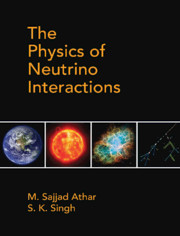Book contents
- Frontmatter
- Dedication
- Contents
- List of Figures
- List of Tables
- Preface
- Acknowledgments
- Chapter 1 Neutrino Properties and Its Interactions
- Chapter 2 Relativistic Particles and Neutrinos
- Chapter 3 Quantization of Free Particle Fields
- Chapter 4 Interacting Fields and Relativistic Perturbation Theory
- Chapter 5 Phenomenological Theory I: Nuclear β-decays and Weak Interaction of Leptons
- Chapter 6 Phenomenological Theory II: Weak Decays of Hadrons
- Chapter 7 Gauge Field Theories and Fundamental Interactions
- Chapter 8 Unified Theory of Electroweak Interactions
- Chapter 9 Neutrino and Electron Scattering from Point Particles
- Chapter 10 Neutrino scattering Cross Sections from Hadrons: Quasielastic Scattering
- Chapter 11 Neutrino Scattering from Hadrons: Inelastic Scattering (I)
- Chapter 12 Neutrino Scattering from Hadrons: Inelastic Scattering (II)
- Chapter 13 Neutrino Scattering from Hadrons: Deep Inelastic Scattering
- Chapter 14 Weak Quasielastic v(⊽)-nucleus Scattering
- Chapter 15 Inelastic Scattering of (Anti)neutrinos from Nuclei
- Chapter 16 Deep Inelastic Scattering of (Anti)neutrinos from Nuclei
- Chapter 17 Neutrino Sources and Detection of Neutrinos
- Chapter 18 Neutrino Mixing and Oscillations
- Chapter 19 Neutrino Astrophysics and the Synthesis of Elements
- Chapter 20 Neutrino Interactions Beyond the Standard Model
- Appendices
- Appendix A Lorentz Transformation and Covariance of the Dirac Equation
- Appendix B Cabibbo Theory
- Appendix C Some Properties of Pauli and Dirac Matrices and Spin Density Matrices
- Appendix D Leptonic and Hadronic Tensors
- Appendix E General Expression for the Total Scattering Cross Section and Decay Rates
- Appendix F Expressions of N(q2), the Coefficients of the Polarization Observables
- References
- Index
Chapter 6 - Phenomenological Theory II: Weak Decays of Hadrons
Published online by Cambridge University Press: 22 May 2020
- Frontmatter
- Dedication
- Contents
- List of Figures
- List of Tables
- Preface
- Acknowledgments
- Chapter 1 Neutrino Properties and Its Interactions
- Chapter 2 Relativistic Particles and Neutrinos
- Chapter 3 Quantization of Free Particle Fields
- Chapter 4 Interacting Fields and Relativistic Perturbation Theory
- Chapter 5 Phenomenological Theory I: Nuclear β-decays and Weak Interaction of Leptons
- Chapter 6 Phenomenological Theory II: Weak Decays of Hadrons
- Chapter 7 Gauge Field Theories and Fundamental Interactions
- Chapter 8 Unified Theory of Electroweak Interactions
- Chapter 9 Neutrino and Electron Scattering from Point Particles
- Chapter 10 Neutrino scattering Cross Sections from Hadrons: Quasielastic Scattering
- Chapter 11 Neutrino Scattering from Hadrons: Inelastic Scattering (I)
- Chapter 12 Neutrino Scattering from Hadrons: Inelastic Scattering (II)
- Chapter 13 Neutrino Scattering from Hadrons: Deep Inelastic Scattering
- Chapter 14 Weak Quasielastic v(⊽)-nucleus Scattering
- Chapter 15 Inelastic Scattering of (Anti)neutrinos from Nuclei
- Chapter 16 Deep Inelastic Scattering of (Anti)neutrinos from Nuclei
- Chapter 17 Neutrino Sources and Detection of Neutrinos
- Chapter 18 Neutrino Mixing and Oscillations
- Chapter 19 Neutrino Astrophysics and the Synthesis of Elements
- Chapter 20 Neutrino Interactions Beyond the Standard Model
- Appendices
- Appendix A Lorentz Transformation and Covariance of the Dirac Equation
- Appendix B Cabibbo Theory
- Appendix C Some Properties of Pauli and Dirac Matrices and Spin Density Matrices
- Appendix D Leptonic and Hadronic Tensors
- Appendix E General Expression for the Total Scattering Cross Section and Decay Rates
- Appendix F Expressions of N(q2), the Coefficients of the Polarization Observables
- References
- Index
Summary
Introduction
Hadrons are strongly interacting particles which also participate in weak andelectromagnetic interactions. They are not elementary particles and arecomposed of quarks, which come in six flavors; and each flavor comes inthree colors (R, B, andG) as shown in Table Hadrons are specified by their quantumnumbers like spin, parity, isospin, strangeness, baryon number, etc., andare classified as mesons and baryons on the basis of their quark content.Mesons are the bound states of a quark and an antiquark pair(qq), while baryons are the bound states of threequarks (qqq). They are bound in such a way that thephysical states of mesons and baryons
are color singlets. The strong forces which bind the quarks together, in thecase of baryons, or quarks and antiquarks together, in the case of mesons,are provided by the exchange of massless vector fields between them calledthe gluons. The dynamics of the strong forces, that is, the binding of thequarks and antiquarks and their interactions is described by the theory ofstrong interactions known as quantum chromodynamics (QCD), in a way similarto QED which describes the interactions among charged particles. In Tables6.2 and 6.3, some of the low lying mesons and baryons, which are consideredin this chapter while discussing their weak interactions, are listed alongwith their quark contents and other quantum numbers.
The theory of the weak interaction of hadrons is not as simple as the weakinteraction of leptons, which has been described in the previous chapter. Wehave seen that the interaction Hamiltonian of the weak interaction, in thecase of leptons, is described by
where
The currents here are of the V − A type. Thesecurrents lμ are constructed from the lepton fieldsψl (x) described by the Diracequation for a point spin particle. In the case of hadrons, the interactionis also of the current × current type with V −A currents at the level of quarks which are considered as pointparticles. However, the hadrons are not point particles.
- Type
- Chapter
- Information
- The Physics of Neutrino Interactions , pp. 215 - 273Publisher: Cambridge University PressPrint publication year: 2020



